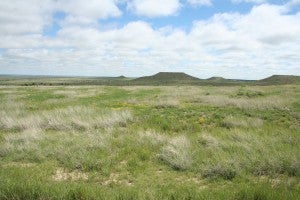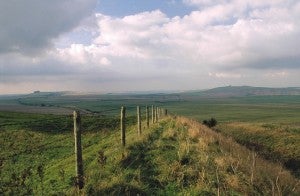
Heartland Ranch in Colorado. Credit: Nicole Rosmarino
One year ago this month the Climate Action Reserve, the premier carbon offset registry for the North American carbon market, approved the voluntary grasslands protocol: a landmark opportunity for ranchers to get paid for keeping their land as grazing lands, versus converting it to crops.
And now, the protocol is underway. Today, the Reserve officially listed the first two grassland conservation carbon projects– the first step in the process towards generating carbon credits for landowners.
The Southern Plains Land Trust, directed by Nicole Rosmarino, enrolled more than 15,000 acres in Southeastern Colorado in the first two projects. She plans to enroll 7,600 more acres in an additional project in 2017.
Even though ranchers lose the opportunity to convert land for crop production, the protocol provides landowners with a guaranteed revenue source in addition to what they earn ranching on the land. Nicole will work with a project developer to monitor and report on the status of the Southern Plains Land Trust’s grasslands. We expect they’ll start earning credits in early 2017 that can later be sold on the North American carbon market.
Here’s why you can get paid for protecting grasslands, too.
Avoiding conversion to cropland

Heartland Ranch in Colorado. Credit: Rich Reading
The conversion of grasslands to croplands releases soil carbon, which contributes to climate change. Additionally, the cultivation of croplands uses machinery and fertilizer that produce more emissions. According to this helpful infographic from the Climate Action Reserve:
- Grasses and shrubs absorb carbon dioxide and store it in their plant tissue and soils, thereby acting as sinks and reservoirs in the global carbon cycle.
- Converting grasslands to cropland disturbs the soil and removes the plants, which releases the stored carbon into the atmosphere.
- When commodity prices increase, they drive the conversion of grasslands to cropland (for food, feed, fiber, and fuels).
- Over the past three centuries, half of the grasslands in the U.S. have been converted to other uses, primarily cropland.
- Seventy-seven percent of new croplands are generated from grasslands.
By protecting and conserving grasslands, landowners avoid the release of carbon into the atmosphere. That’s why the grasslands protocol offers payments for doing just that.
As Nicole told me, “The Grasslands Protocol recognizes what many landowners in the southern Great Plains have understood since the Dust Bowl: it’s better to keep native grasslands ‘right side up’ and not plow them under for short-sighted profits. Making grassland preservation more financially attractive is better for both the region and the global climate.”
Generating payments
 In order to be eligible, the land for the project must have been grasslands for at least the past 10 years. Participation requires placing a permanent conservation easement that includes a specific clause preventing the conversion of grasslands to croplands.
In order to be eligible, the land for the project must have been grasslands for at least the past 10 years. Participation requires placing a permanent conservation easement that includes a specific clause preventing the conversion of grasslands to croplands.
Landowners who recently placed a conservation easement on their property or are in the process of doing so are ideal candidates for this protocol. Moreover, by participating in a carbon credit project, landowners can receive benefits from both the easement tax credit and the grassland carbon credits, whether they are pursued at the same time or several months apart.
Landowners who participate in this pilot project before the end of 2017 get an added bonus. These early participants in the program will have a large portion of their project development costs covered, as a result of a grant from the U.S. Department of Agriculture’s Natural Resources Conservation Service.









